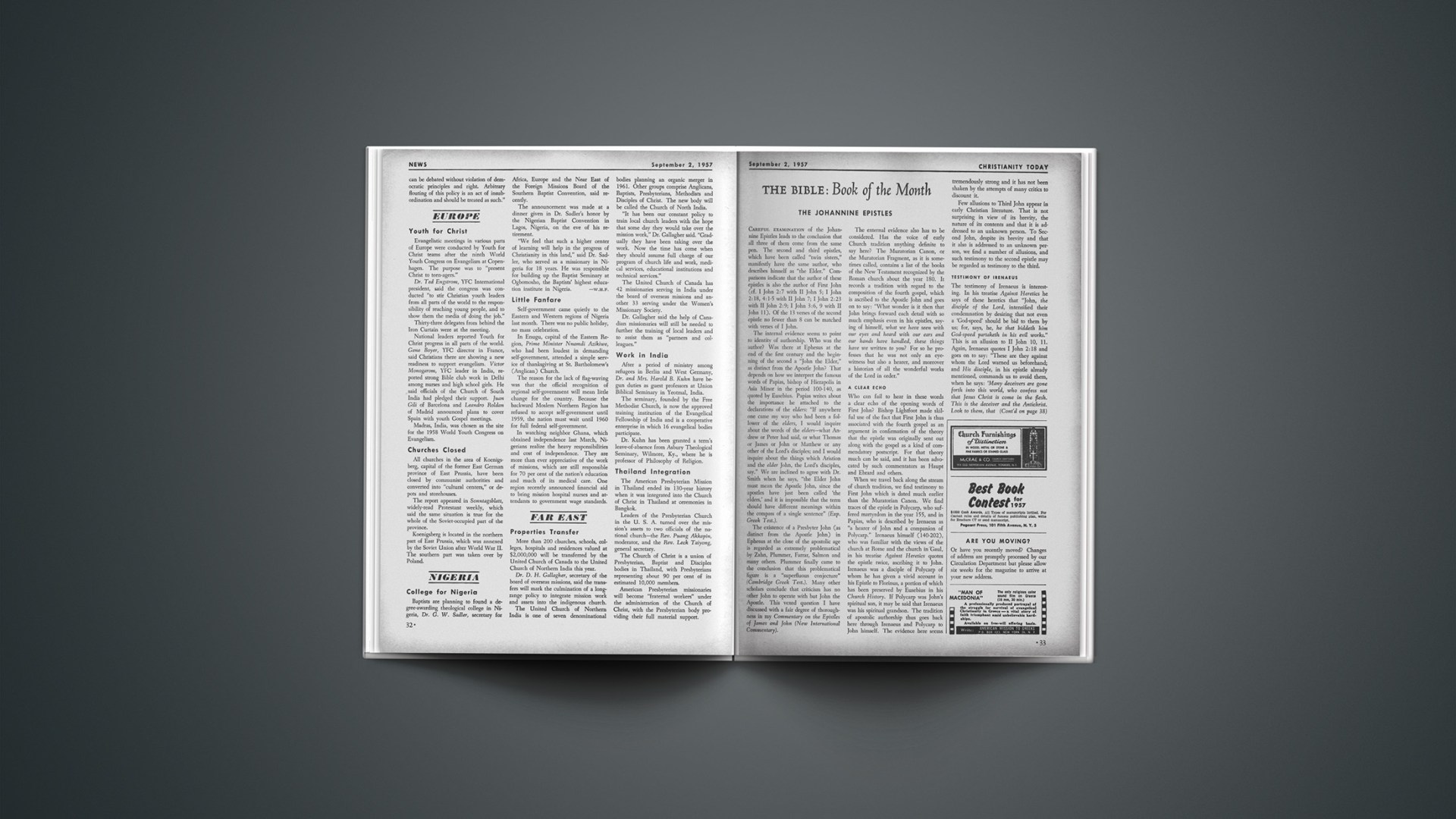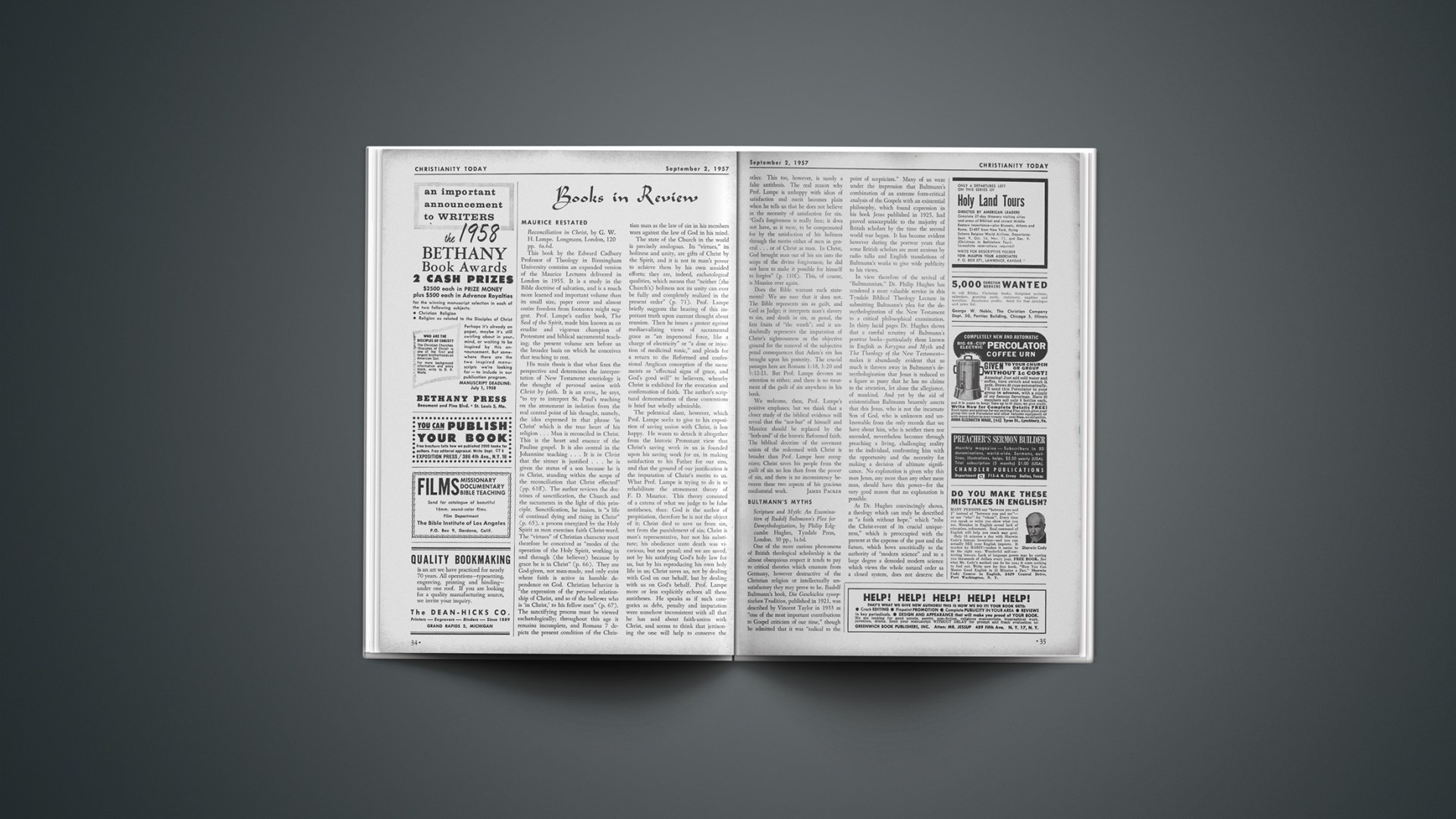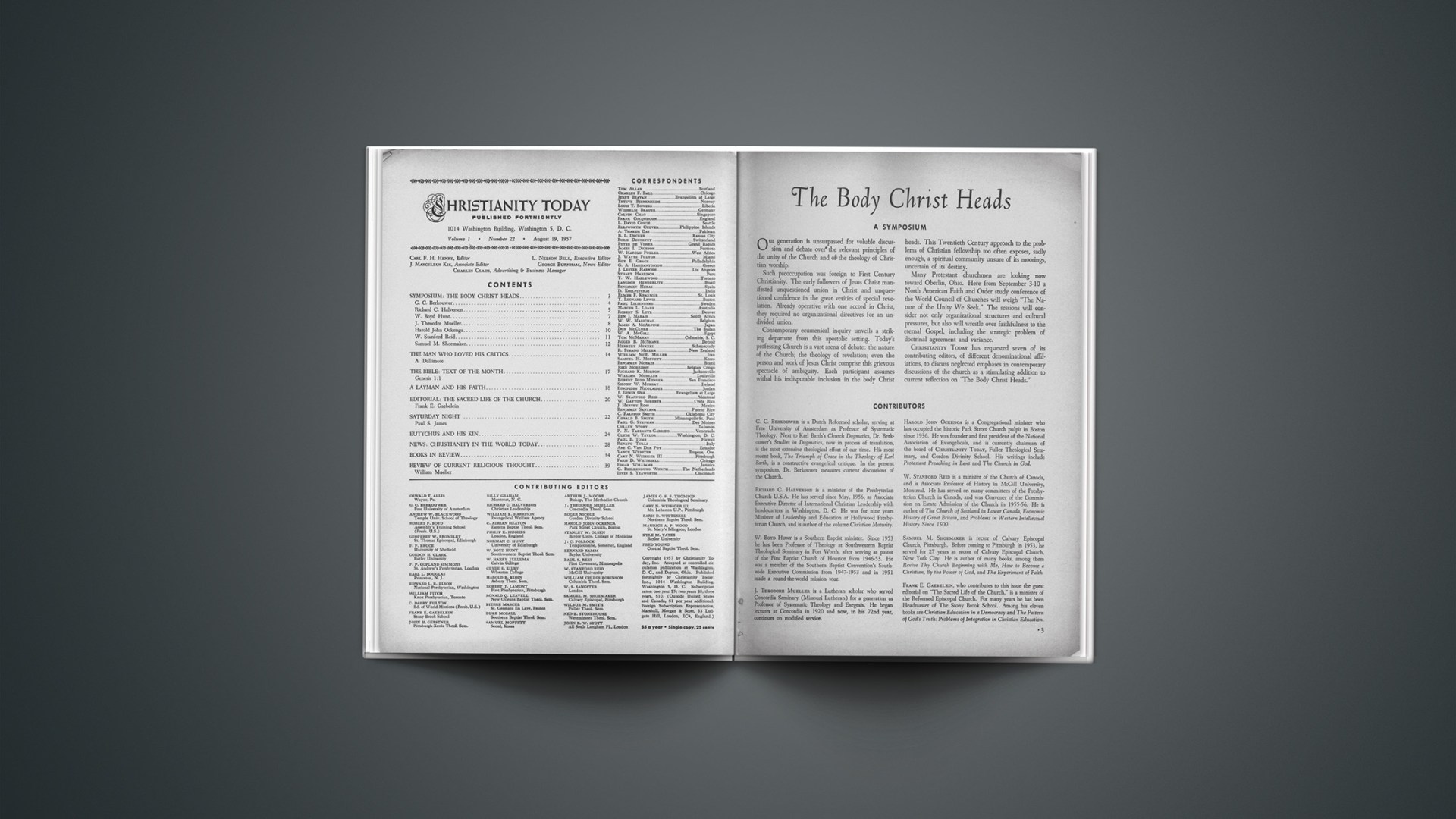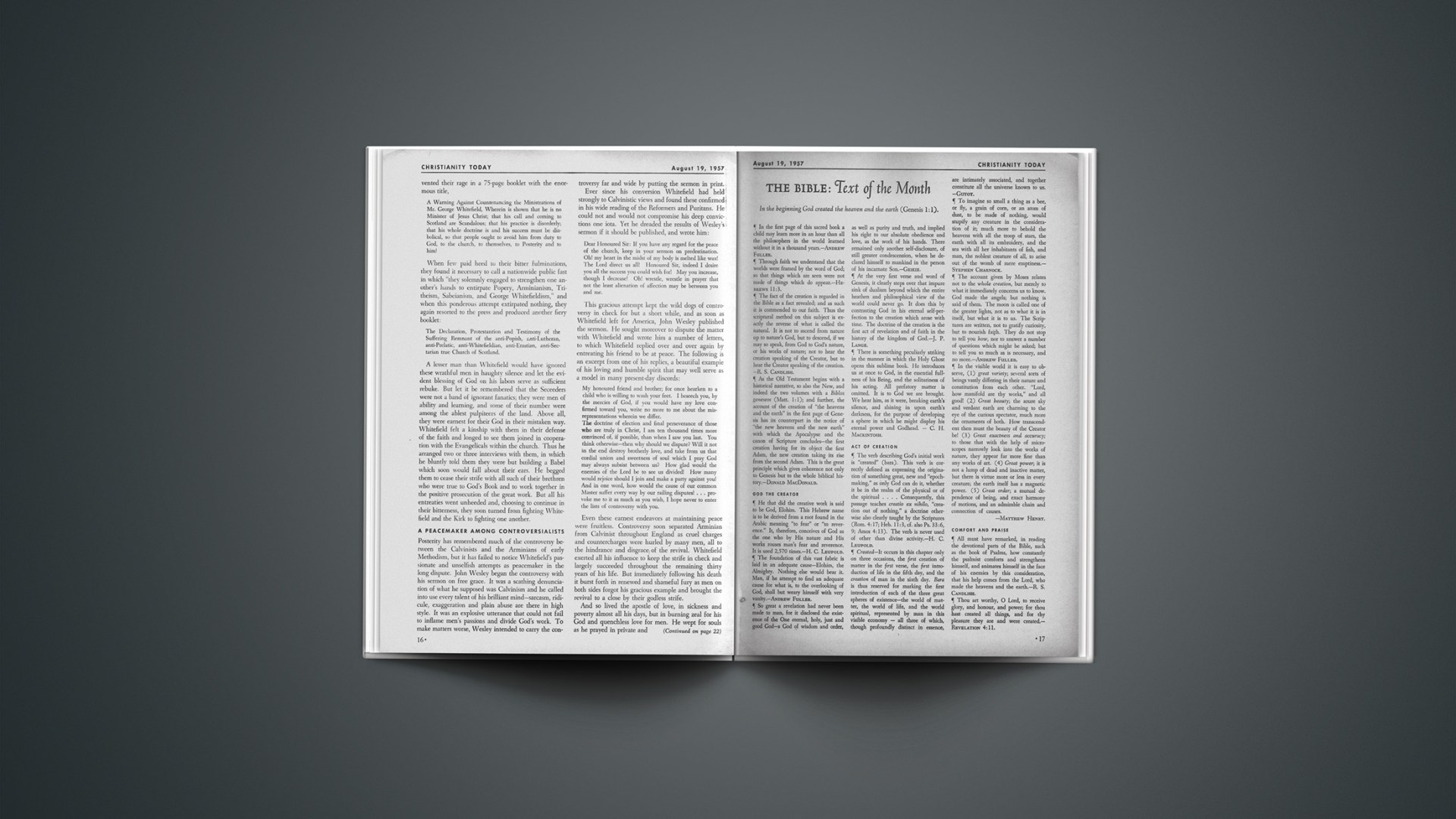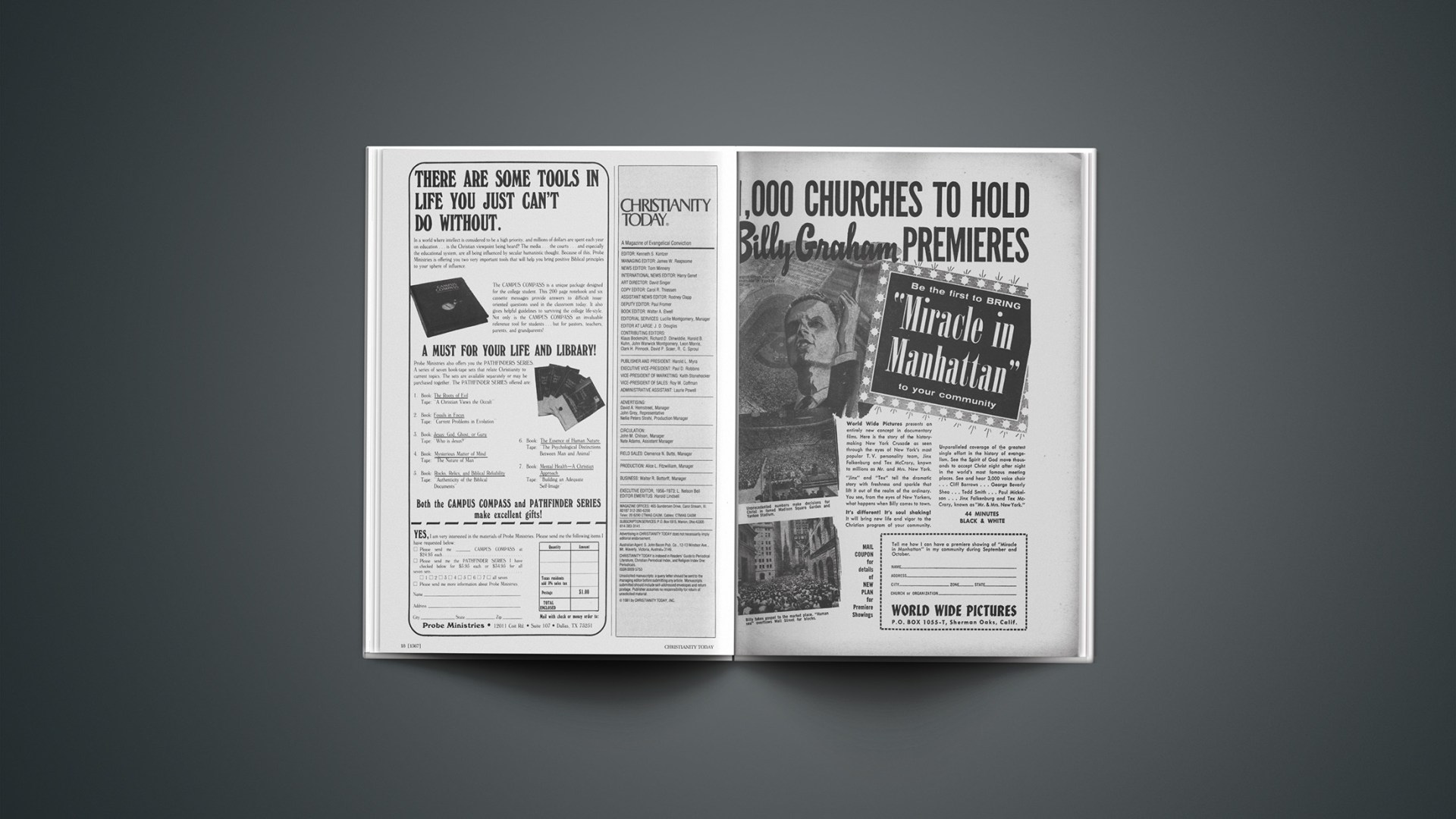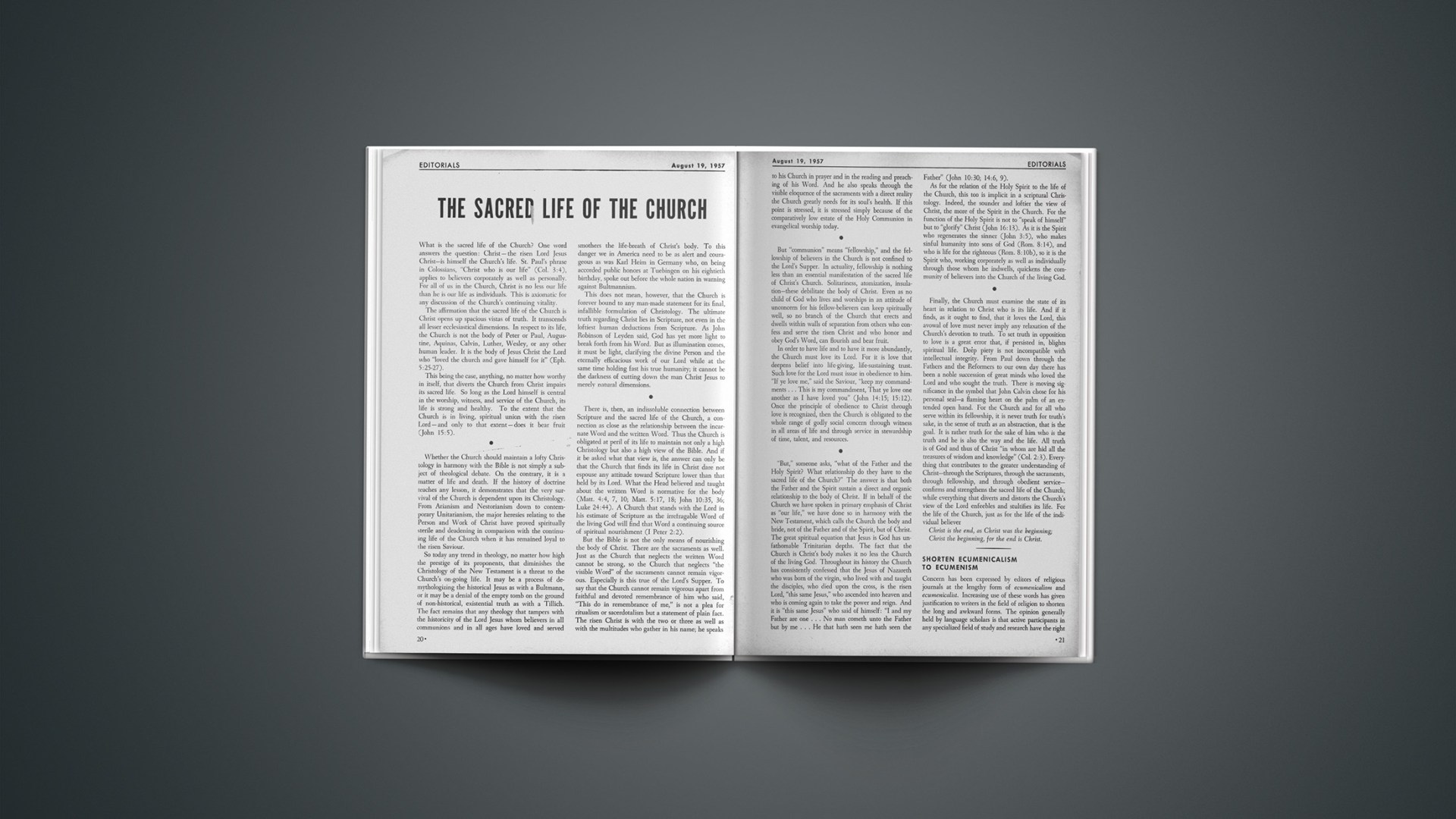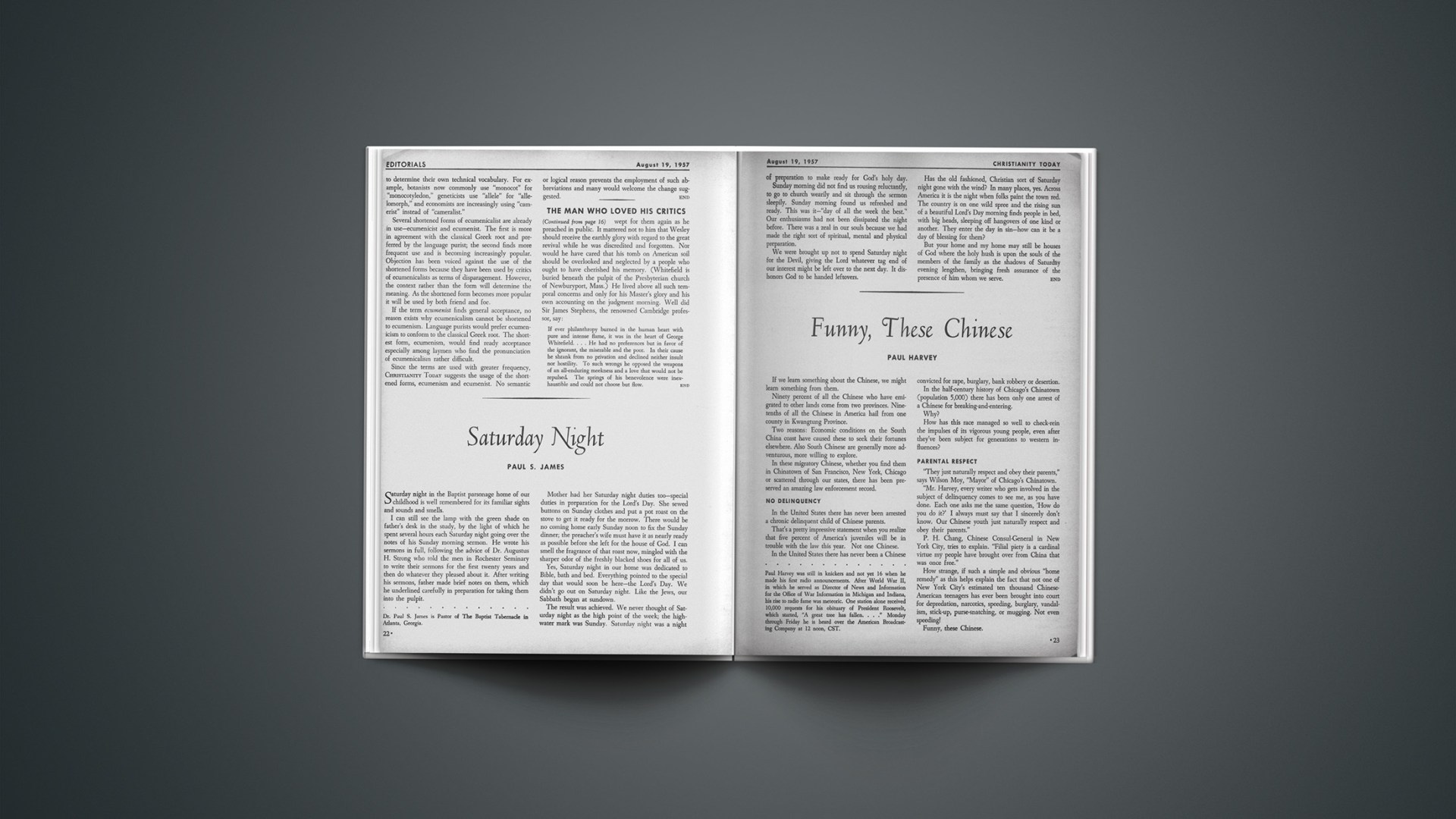Careful examination of the Johannine Epistles leads to the conclusion that all three of them come from the same pen. The second and third epistles, which have been called “twin sisters,” manifestly have the same author, who describes himself as “the Elder.” Comparisons indicate that the author of these epistles is also the author of First John (cf. 1 John 2:7 with 2 John 5; 1 John 2:18, 4:1–5 with 2 John 7; 1 John 2:23 with 2 John 2, 9; 1 John 3:6, 9 with 2 John 11). Of the 13 verses of the second epistle no fewer than 8 can be matched with verses of I John.
The internal evidence seems to point to identity of authorship. Who was the author? Was there at Ephesus at the end of the first century and the beginning of the second a “John the Elder,” as distinct from the Apostle John? That depends on how we interpret the famous words of Papias, bishop of Hierapolis in Asia Minor in the period 100–140, as quoted by Eusebius. Papias writes about the importance he attached to the declarations of the elders: “If anywhere one came my way who had been a follower of the elders, I would inquire about the words of the elders—what Andrew or Peter had said, or what Thomas or James or John or Matthew or any other of the Lord’s disciples; and I would inquire about the things which Aristion and the elder John, the Lord’s disciples, say.” We are inclined to agree with Dr. Smith when he says, “the Elder John must mean the Apostle John, since the apostles have just been called ‘the elders,’ and it is impossible that the term should have different meanings within the compass of a single sentence” (Exp. Greek Test.).
The existence of a Presbyter John (as distinct from the Apostle John) in Ephesus at the close of the apostolic age is regarded as extremely problematical by Zahn, Plummer, Farrar, Salmon and many others. Plummer finally came to the conclusion that this problematical figure is a “superfluous conjecture” (Cambridge Greek Test.). Many other scholars conclude that criticism has no other John to operate with but John the Apostle. This vexed question I have discussed with a fair degree of thoroughness in my Commentary on the Epistles of James and John (New International Commentary).
The external evidence also has to be considered. Has the voice of early Church tradition anything definite to say here? The Muratorian Canon, or the Muratorian Fragment, as it is sometimes called, contains a list of the books of the New Testament recognized by the Roman church about the year 180. It records a tradition with regard to the composition of the fourth gospel, which is ascribed to the Apostle John and goes on to say: “What wonder is it then that John brings forward each detail with so much emphasis even in his epistles, saying of himself, what we have seen with our eyes and heard with our ears and our hands have handled, these things have we written to you? For so he professes that he was not only an eyewitness but also a hearer, and moreover a historian of all the wonderful works of the Lord in order.”
A Clear Echo
Who can fail to hear in these words a clear echo of the opening words of First John? Bishop Lightfoot made skilful use of the fact that First John is thus associated with the fourth gospel as an argument in confirmation of the theory that the epistle was originally sent out along with the gospel as a kind of commendatory postscript. For that theory much can be said, and it has been advocated by such commentators as Haupt and Ebrard and others.
When we travel back along the stream of church tradition, we find testimony to First John which is dated much earlier than the Muratorian Canon. We find traces of the epistle in Polycarp, who suffered martyrdom in the year 155, and in Papias, who is described by Irenaeus as “a hearer of John and a companion of Polycarp.” Irenaeus himself (140–202), who was familiar with the views of the church at Rome and the church in Gaul, in his treatise Against Heretics quotes the epistle twice, ascribing it to John. Irenaeus was a disciple of Polycarp of whom he has given a vivid account in his Epistle to Florinus, a portion of which has been preserved by Eusebius in his Church History. If Polycarp was John’s spiritual son, it may be said that Irenaeus was his spiritual grandson. The tradition of apostolic authorship thus goes back here through Irenaeus and Polycarp to John himself. The evidence here seems tremendously strong and it has not been shaken by the attempts of many critics to discount it.
Few allusions to Third John appear in early Christian literature. That is not surprising in view of its brevity, the nature of its contents and that it is addressed to an unknown person. To Second John, despite its brevity and that it also is addressed to an unknown person, we find a number of allusions, and such testimony to the second epistle may be regarded as testimony to the third.
Testimony Of Irenaeus
The testimony of Irenaeus is interesting. In his treatise Against Heretics he says of these heretics that “John, the disciple of the Lord, intensified their condemnation by desiring that not even a ‘God-speed’ should be bid to them by us; for, says, he, he that biddeth him God-speed partaketh in his evil works.” This is an allusion to 2 John 10, 11. Again, Irenaeus quotes 1 John 2:18 and goes on to say: “These are they against whom the Lord warned us beforehand; and His disciple, in his epistle already mentioned, commands us to avoid them, when he says: ‘Many deceivers are gone forth into this world, who confess not that Jesus Christ is come in the flesh. This is the deceiver and the Antichrist. Look to them, that ye lose not that which ye have wrought.’ ” This is an allusion to 2 John: 7, 8, with some slight variations that indicate Irenaeus had a different text from ours. In that second quotation he cites words of the second epistle as though they belonged to the first, but that is just a small slip on his part; it is evident that he regards the two epistles as coming from the same man.
With regard to the designation “elder” we ought to note that Peter, one of the disciples of the Lord, so designates himself (1 Pet. 5:1). If he could do that, so also could John. It may be that he uses that title as the last survivor of the apostolic company, about the end of the first century.
A Polemical Purpose
John had a polemical purpose in writing his first epistle. He is definitely on the warpath against certain dangerous heresies that were threatening to invade the churches of Asia Minor. The heresies in view, likely, are chiefly those associated with Cerinthus, who was a native of Egypt and taught in Asia Minor at the same time as John. We owe our information about him to Irenaeus and to other early writers. Irenaeus tells us that Cerinthus taught that “Jesus had not been begotten of a virgin, but had been born of Joseph and Mary as a son in like manner to all the rest of men, and became more righteous and prudent and wise. And after the Baptist the Christ descended into him from the Sovereignty which is over the Universe, in the form of a dove; and then He proclaimed the unknown Father and accomplished mighty works, but at the end the Christ withdrew from the Jesus, and the Jesus had suffered and been raised, but the Christ had continued throughout impassible, being spiritual.”
These deadly heresies aroused strong indignation in the soul of John. A knowledge of the facts about the teaching of Cerinthus enables us to understand John’s meaning when he writes (5:6) that Jesus Christ, in indissoluble union, came through, or by means of water and blood; not with the water only, but with the water and with the blood. His baptism in the Jordan and his death on Calvary were both essential parts of his self-manifestation, and it is the blood of Jesus, God’s Son, which cleanses from all sin (1:7).
To Establish In Truth
While John apparently never loses sight altogether of the heresies of Cerinthus in any part of this epistle, he has also a more positive purpose in his mind of writing. He wants his “children” to be firmly established in the truth and especially, to understand clearly all that is involved in Christian love, love to God and love to men. Three times he states his purpose in writing (1:4, 2:1, 5:13). The best way to become immune against infection by dangerous heresy is to know the truth (Jn. 8:32) and to be so firmly established in it that any teaching that is alien to the truth as it is in Jesus (Eph. 4:21) will at once be detected by us in its true character. John is here in agreement with Peter, who tells us that the way in which men of unstable mind can attain to spiritual stedfastness is to be in the grace and in the knowledge of our Lord and Saviour Jesus Christ, and, in that blessed sphere, as in our abiding spiritual home, to grow (2 Pet. 3:17, 18).
Dr. James Moffat has said we would not have suffered much loss if the second and third epistles of John had been excluded from the New Testament canon. On the contrary, we would have suffered very serious spiritual loss if we had never read the subtle rebuke of “advanced” thinkers in 2 John 9. The true reading there is not the reading which lies behind the AV rendering, “whosoever transgresseth,” but the reading which lies behind the RV rendering, “whosoever goes onward” and the RSV, “any one who goes ahead.” Real advance in Christian truth comes only as we abide in the teaching of Christ and are led by the Spirit of truth step by step into the fullness of its meaning (John 16:13). Any teaching that claims to be an advance beyond the teaching of Christ, as the Cerinthian heresy no doubt claimed to be, is teaching that is dominated by the “spirit of error” (1 John 4:6) and will lead to barren regions of futile and often dangerous speculation.
Would we not have been spiritually poorer if we had lacked the scathing portrait of Diotrephes in the third epistle? Dr. A. T. Robertson once wrote an article on Diotrephes for a church magazine in which he developed the idea that Diotrephes was a typical “church boss,” and the result was that some twenty deacons wrote to the editor cancelling their subscriptions because of the personal attack on them!
Tools For Exposition
Some commentaries which may be recommended are those by Alford, Huther (in Meyer), Haupt (1st Ep.), Westcott, Plummer in Cambridge Greek Testament, Smith in Expositor’s Greek Testament, Farrar in Early Days of Christianity, and G. G. Findlay, Fellowship in the Life Eternal. Dr. Samuel Cox’s little book Private Letters of St. Paul and St. John deals in a deeply interesting and very suggestive way with Second and Third John.
ALEXANDER ROSS

